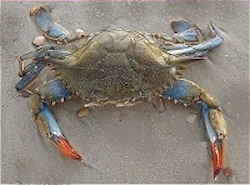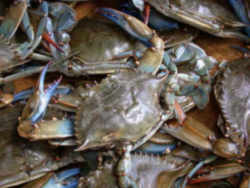Maryland State Crustacean
Blue Crab

(Callinectes sapidus Rathbun)
Adopted in 1989
In 1989, the Maryland Blue Crab (Callinectes sapidus Rathbun) was designated the State Crustacean (Chapter 724, Acts of
1989; Code State Government Article, sec. 13-301(b)). Its name honors Mary Jane Rathbun (1860-1943), the scientist who described the species in 1896.
The blue crab's scientific name translates as "beautiful swimmer that is savory." Blue crab meat sometimes is compared to the sweetness of lobster
meat; the flavor best appreciated by cracking and eating steamed hardshells or feasting on softshells. Crab is prepared in restaurant and home kitchens
in innumerable ways, steamed or sauteed, as Maryland Crab Cakes and Crab Imperial, or in crab soup and crab dip.
Maryland State Crustacean: Blue Crab

Callinectes sapidus
(from the Greek calli- = "beautiful", nectes = "swimmer", and Latin sapidus = "savory"), the blue crab, Atlantic blue
crab, or regionally as the Chesapeake blue crab, is a species of crab native to the waters of the western Atlantic Ocean and the Gulf of Mexico, and
introduced internationally.
C. sapidus is of significant culinary and economic importance in the United States, particularly in Louisiana and in the Chesapeake Bay. It
is the Maryland state crustacean and is the state's largest commercial fishery.
Providing a seafood bounty, life becomes tenuous for baby blue crabs. As they grow from a larval stage to a recognizable crab shape, most fall prey to predators. Few survive their first year. For those who do, their life expectancy in Chesapeake Bay is estimated at 2 and 1/2 to 3 years (as of October 2000). Most are harvested, however, before they get any older. Under better circumstances, scientists believe that blue crabs could live as long as 8 years.
The brackish (slightly salty) water of Chesapeake Bay provides an ideal habitat for the blue crab. Integral to the State's economy, its harvest is carefully nurtured and eagerly anticipated. In harvesting, commercial crabbers use crab pots as their main tools. Trotlines preceded this method and served well for many years. Indeed, stalwart recreational fishermen still prefer crabbing the old-fashioned way, with a dip net.
Blue crabs are harvested as hard shell crabs, peeler crabs (just prior to molting), and soft shell crabs (immediately after the molt). The just-right salinity waters of the Wye and Chester Rivers and Eastern Bay frequently result in the harvesting of giant males, called "jimmies." In Maryland, the legal size for harvesting male crabs is 5 inches or more across; peelers, 3 inches across; and soft crabs, 3 and 1/2 inches across. No size limits are set for mature females ("sooks").
In Maryland, blue crabs are the most valuable commercial fishery. The annual catch of hard crabs from the Chesapeake Bay accounts for over 50 percent of total landings.
Maryland Law
The law designating the Maryland Blue Crab as the official Maryland state crustacean is found in the Maryland Statutes, Title 13, Section 13-320.
STATE GOVERNMENT
§ 13-320 - State crustacean.
§ 13-320.
(a) The Baltimore Checkerspot Butterfly (Euphydryas phaeton) is the State insect.
(b) The Maryland Blue Crab (Callinectes sapidus) is the State crustacean.
Taxonomic Hierarchy: Maryland Blue Crab
Superkingdom: Eukaryota All animals, plants, fungi, and protists.
Kingdom: Animalia - Animals.
Subkingdom: Metazoa - Multicellular animals.
Phylum: Arthropoda J- ointed leg invertebrates.
Subphylum: Crustacea - Having a crustlike shell.
Class: Malacostraca - Shrimps, Crabs, Lobsters.
Subclass: Eumalacostraca - Have a 5-8-6 (head-thorax-abdomen) segment body plan.
Superorder: Eucarida - Characterized by having the carapace fused to all thoracic segments, and by the possession of stalked eyes.
Order: DecapodaTen legs.
Suborder: Pleocyemata - Gills lacking secondary branches and eggs carried on pleopods before hatching.
Infraorder: Brachyura - True crabs. Characterized by a reduced abdomen, folded
beneath the cephalothorax, and inserted between the pereiopods or in a special cavity, which prevents it from impeding movements.
Section: Eubrachyura - Press-button holding system, consisting of a prominence always on the fifth sternite and a socket always positioned on the
sixth abdominal segment. Prevents abdomen from moving.
Subsection: Heterotremata - Group in which the genital openings of the males are on the appendages and those of the females are
on the thorax.
Superfamily: Portunoidea
Family: Portunidae - Swimming crabs.
Subfamily: Portuninae
Genus: Callinectes - Greek word for beautiful swimmer (Calli = beautiful, Nectes = swimmer).
Species: Sapidus - Latin word for savory.
Scientific name: Callinectes sapidus








